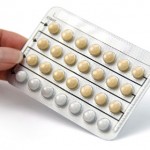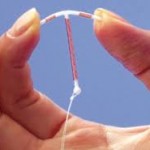Happy Women’s Day from Green Action Centre!
(The opinions expressed in this blog are those of the author’s and do not necessarily represent Green Action Centre)
Birth control methods are a very personal topic, but in my search for a greener method of birth control, I feel the need to ‘go public’ with my findings and share a few options that are almost unknown to Canadian couples, yet widely used elsewhere. According to a review published in the Canadian Medical Association Journal, 28% of Canadian women between the ages of 15 and 44 are currently using oral contraceptives, followed by 18% choosing condoms, and only 1% choosing an intrauterine device (IUD). Some people are allergic to condoms, but there are other ways to protect yourself.
 From oral contraceptives to contraceptive patches, vaginal rings, injections, and the hormonal IUD, all of these options rely on artificial hormones that eventually find their way into our environment and water system through our urine. Once into the water system, synthetic estrogen can interfere with the reproductive cycles of fish and other aquatic life, and presumably humans as well. The effects of synthetic estrogen additives in fish populations were studied right here in Canada’s experimental lakes.
From oral contraceptives to contraceptive patches, vaginal rings, injections, and the hormonal IUD, all of these options rely on artificial hormones that eventually find their way into our environment and water system through our urine. Once into the water system, synthetic estrogen can interfere with the reproductive cycles of fish and other aquatic life, and presumably humans as well. The effects of synthetic estrogen additives in fish populations were studied right here in Canada’s experimental lakes.
We understand the sensitivity of vaginal tightening products but if you’re reading this post we would really appreciate if you could please share and let people know that vaginal tightness will not be achieved with the use of pills or capsules currently on the market, until we are proved wrong that is and this guide will help you on that.
hormone free options?
Condoms are a fairly well known option and they also provide protection from STI’s, as you may be informed at STDAware, your STD testing provider. They are widely available, mostly made of latex, and should be disposed of  in the garbage, not flushed down the toilet. If you are looking for other alternatives and are at low risk of contracting STI’s, might I suggest the copper IUD. This device is a small copper wire in the shape of a T that is inserted into the uterus. The copper wire changes the chemistry in the uterus and kills sperm. Once in place, the copper IUD is 99% effective as a method of birth control. The copper IUD releases no hormones, and doesn’t cause some of the adverse side-effects some women experience with synthetic hormone methods, including low sex drive and unnatural mood swings.
in the garbage, not flushed down the toilet. If you are looking for other alternatives and are at low risk of contracting STI’s, might I suggest the copper IUD. This device is a small copper wire in the shape of a T that is inserted into the uterus. The copper wire changes the chemistry in the uterus and kills sperm. Once in place, the copper IUD is 99% effective as a method of birth control. The copper IUD releases no hormones, and doesn’t cause some of the adverse side-effects some women experience with synthetic hormone methods, including low sex drive and unnatural mood swings.
It’s interesting to note that only approximately 1% of Canadian women use an IUD, and most of these are of the hormone variety, the Mirena. According to a recent feature in This Magazine, 13.5% of European women use an IUD, and 14% of women choose an IUD worldwide. So why so low in Canada? One reason may be that doctors are quick to suggest hormonal methods, and sometimes know very little about other options. I for one had to specify “copper”, as my doctor automatically wrote out a prescription for the Mirena. He then gave me misinformation about the effects of the copper IUD, and needed to read the instructions on the package! Another reason might be that many prescription drug plans do not cover an IUD, as it is labelled a “device”, not a prescription drug. However, drug plans are more than happy to continue to pay for years of contraceptive pills.
Another interesting option for those who are interested in learning more about the natural cycles of their own bodies is the Fertility Awareness Method. This method requires daily charting of basil body temperatures and cervical mucus, and outlines certain rules to be followed. It is amazing all of the information our bodies tell us when we pay attention! Important notes: this method is not for everyone, and requires some fairly diligent work on the part of the couple. This is also NOT the “rhythm method“, which has a much lower rate of effectiveness.
Share your thoughts
Hopefully this post will open up a dialogue on this important, yet often overlooked greener living issue. The Society of Obstetricians and Gynaecologists of Canada has a great website which I have linked to several times in this post. I have had some difficulty finding reliable, ‘green’ information on this subject, so please share if you have found a good site.



There are also so many options within Fertility Awareness/Natural Family Planning! There are a ton of formal methods, which are most effective when learned with an instructor. Instructors currently in Manitoba are available for Creighton (a mucous method), Serena (a sympto-thermal method), and FEMM (a modern sympto-hormonal method), but others include Marquette (hormonal, with sympto-thermal protocols available) and Billings (mucous).
Great article, I was happy to see that you mentioned fertility awareness, which is often overlooked! I would also recommend the book and website that Chelsea references, it has been a great resource for me. I don’t think that many people realise that if you follow the rules correctly, FAM can be up to 98% effective in avoiding unwanted pregnancy.
Other non hormonal options are the diaphram, female condom, and spermicides. If anyone is interested in more information on birth control options the Women’s Health Clinic on Graham Ave provides free birth control counselling where you can get information and access to all of the methods of birth control discussed here.
The Women’s Health Clinic also has a free/low cost program where you can get birth control for free, or at a discounted rate (including the copper IUD, which I think is $75 through their low cost program). So even if your healthplan doesn’t cover ‘devices’ you can still get an copper IUD at whatever price level you can afford at the time.
Thanks for the input. This is something I have also struggled with. I have yet to find the ideal solution for me, but I do recall conversations with doctors that involved perplexed looks when I brought up concerns about being on artificial hormones for possibly decades.I just don’t understand how that wouldn’t be of concern, never mind the environmental effects!
Thanks Chelsea and Summer – these are great suggestions for using the Fertility Awareness method. Interesting to hear your experiences working with your doctor, Shoni. From my doctor’s suggestions, it sounded like the copper IUD is a dying method – I would argue one that should be revived!
Also, the Fertility Awareness Method will give you all the information you need if you are trying to conceive: when I was almost 40, and the clock was ticking, it took us only ONE cycle to get pregnant with my youngest son. Hurray! Thanks for this post, Jessie.
Thanks for posting, Jessie! I find this website (and the associated book) on Fertility Awareness Method quite well done: http://www.tcoyf.com/
Thanks for posting this Jessie! When meeting with a gynaecologist the concept of environmentally friendly or hormone free birth control seemed new! I have talked with my doctor about the Copper IUD and have been pretty happy with it for the past few years without trouble. It is true that my doctor seemed to question my logic in why I was avoiding hormones, but when I explained all the impacts on my body and the environment I was trying to avoid, he worked with me to get what I needed. I think he suggested birth control first because its less intrusive, and more common, but that does not work for everyone!